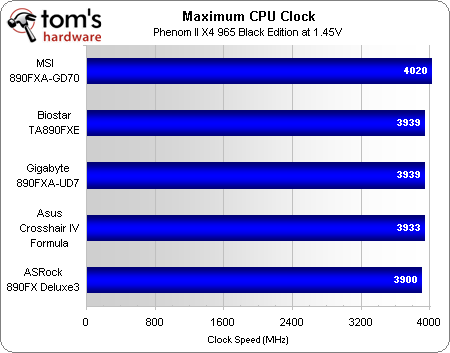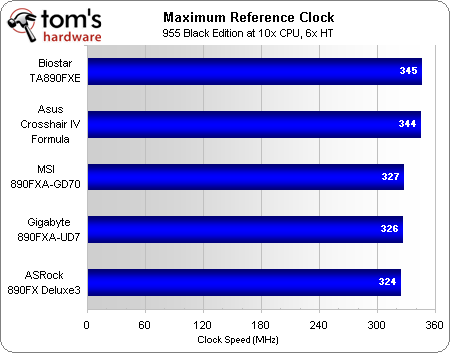Five AMD 890FX-Based Motherboards Compared
Adding SATA 6 Gb/s and two more USB 2.0 ports, AMD’s flagship northbridge has evolved into the 890FX. Just as important are the evolutionary steps several manufacturers have taken in motherboard design. Today we examine five examples.
Overclocking
| BIOS Frequency and Voltage settings (for overclocking) | |||||
|---|---|---|---|---|---|
| Row 0 - Cell 0 | ASRock 890FX Deluxe3 | Asus Crosshair IV Formula | Biostar TA890FXE | Gigabyte 890FXA-UD7 | MSI 890FXA-GD70 |
| Reference Clock | 150-500 MHz (1 MHz) | 100-600 MHz (1 MHz) | 200-600 MHz (1 MHz) | 200-500 MHz (1 MHz) | 190-690 MHz (1 MHz) |
| CPU Multiplier | Yes | Yes | Yes | Yes | Yes |
| DRAM Data Rates | REF x4-x8 (x1.33) | REF x4-x8 (x1.33) | REF x4-x8 (x1.33) | REF x4-x8 (x1.33) | REF x4-x8 (x1.33) |
| PCIe Clock | 75-250 MHz (1 MHz) | 100-150 MHz (1 MHz) | Not Adjustable | 100-150 MHz (1 MHz) | 90-190 MHz (1 MHz) |
| CPU Vcore | 0.60-2.00 V (12.5 mV) | 0.68-1.78 V (3.125 mV) | +1.45 V (50 mV) | -0.6 to +0.6 V (25 mV) | 0.76-2.37 V (4 mV) |
| IMC Voltage | 0.6-2.0 V (12.5 mV) | 0.4-1.5 V (3.125 mV) | +0.20 V (50 mV) | -0.6 to +0.6 V (25 mV) | 0.78-1.73 V (1 mV) |
| 890GX Voltage | 1.08-1.79 V (12.5 mV) | 0.8-2.0 V (12.5 mV) | +0.40 V (10 mV) | 0.95-1.45 V (20 mV) | 0.88-1.39 V (5.5 mV) |
| SB850 Voltage | 1.11-1.51 V (50 mV) | 1.11-1.80 V (13.25 mV) | +0.40 V (10 mV) | 1.10-1.46 V (20 mV) | 0.95-1.58 V (30 mV) |
| DRAM Voltage | 1.32-2.24 V (17.5 mV) | 1.20-2.90 V (12.5 mV) | -0.4 to +0.63V (10 mV) | 1.21-2.41 V (20 mV) | 0.97-2.49 V (~8 mV) |
| CAS Latency | 4-12 Cycles | 4-12 Cycles | 4-12 Cycles | 4-12 Cycles | 4-12 Cycles |
| tRCD | 4-12 Cycles | 4-12 Cycles | 5-12 Cycles | 5-12 Cycles | 5-12 Cycles |
| tRP | 5-12 Cycles | 5-12 Cycles | 5-12 Cycles | 5-12 Cycles | 5-12 Cycles |
| tRAS | 15-30 Cycles | 15-30 Cycles | 15-30 Cycles | 15-30 Cycles | 15-30 Cycles |
All five motherboards provide voltage ranges that far exceed our safe-and-sane limits, along with frequency ranges that exceed the speeds achievable using even the highest voltage levels. Based on reader recommendations for long-term operation of C3-stepping Phenom II cores, we’ve dropped today’s O/C voltage to 1.45V.
MSI’s 890FXA-GD70 was the only motherboard that allowed us to set 1.450 V, while its competitors settled in at 1.440 V. That 10 mV difference fully accounts for its 81 MHz advantage. We confirmed through additional testing that if our limit had been 1.46 V, a different victor would have emerged.
Biostar and Asus lead in maximum base clock.
The Crosshair IV Formula walks away with the memory overclocking lead. This is also the board that leads in Sandra Memory Bandwidth, with advanced timings set to “automatic” on all boards in both tests. The most likely reason for this outcome is a BIOS that compensates its memory timings more drastically as clock speeds are increased, though there’s always the possibility that Asus simply laid out its memory traces a little better.
Get Tom's Hardware's best news and in-depth reviews, straight to your inbox.
Current page: Overclocking
Prev Page Benchmark Results: Synthetic Next Page Power, Heat, And Efficiency-
makwy2 Great article. Very informative!Reply
One little suggestion, in the features comparison it would be nice to include a row on the cost of these mobos. As one eventually reads in the Conclusion there is quite a bit of difference between them in this area but if this 'stat' was featured I would be able to focus only on the boards within my price range. I know that it would be hard to keep up to date and such but it would really be a service to those of us who are not made of money. -
Lmeow I'd personally go for the Crosshair IV Formula simply because of the kickass colour scheme. :DReply -
xurwin uhuh! i really like the crosshair IV formula for its design and Awesome color! wish every mobo has a creativity designReply -
joytech22 Ugh this year i already made some horrible decisions, honestly didn't think the Asus board would look so beautiful! i really wanted that board too but i already ordered a different Asus board for SLi support (with AM3)..Reply
*Sigh* -
liquidsnake718 interesting and very persuasive article as i was seriously thinking of getting an AMD based system instead just a few weeks ago until I finally bought a new processor. I still dont have the mb yet but reading this article made me want to get the Asus or the Gigabyte board. I would have possibly gone for a phenom II x4 or even x6 but its too late! What a good read this was and I am slowly understanding the value oriented target market that AMD and ATi offer to beginners and enthusiast builders and overclockers.Reply
Truly.... if not for getting my i7930 I would have bought these motherboards first!
I have just purchased a i7 chip x58 chip but reading this article actually made me regret it! I have yet to buy a mb as the ud4 isnt available in Manila yet.
I will build this pc slowly but make it the best possible in the timeframe while I eke out the best of my current c2d system and netbook in the meantime. -
dEAne I have a gigabyte mobo and Its good, One thing I don't like is that DDR3 cannot use past 1333 range if you want to use 1600 only few slots are available.Reply -
xurwin dEAneI have a gigabyte mobo and Its good, One thing I don't like is that DDR3 cannot use past 1333 range if you want to use 1600 only few slots are available. now now. breathe slowly. ASUS CROSSHAIR IV FORMULA 890FX!!!Reply



